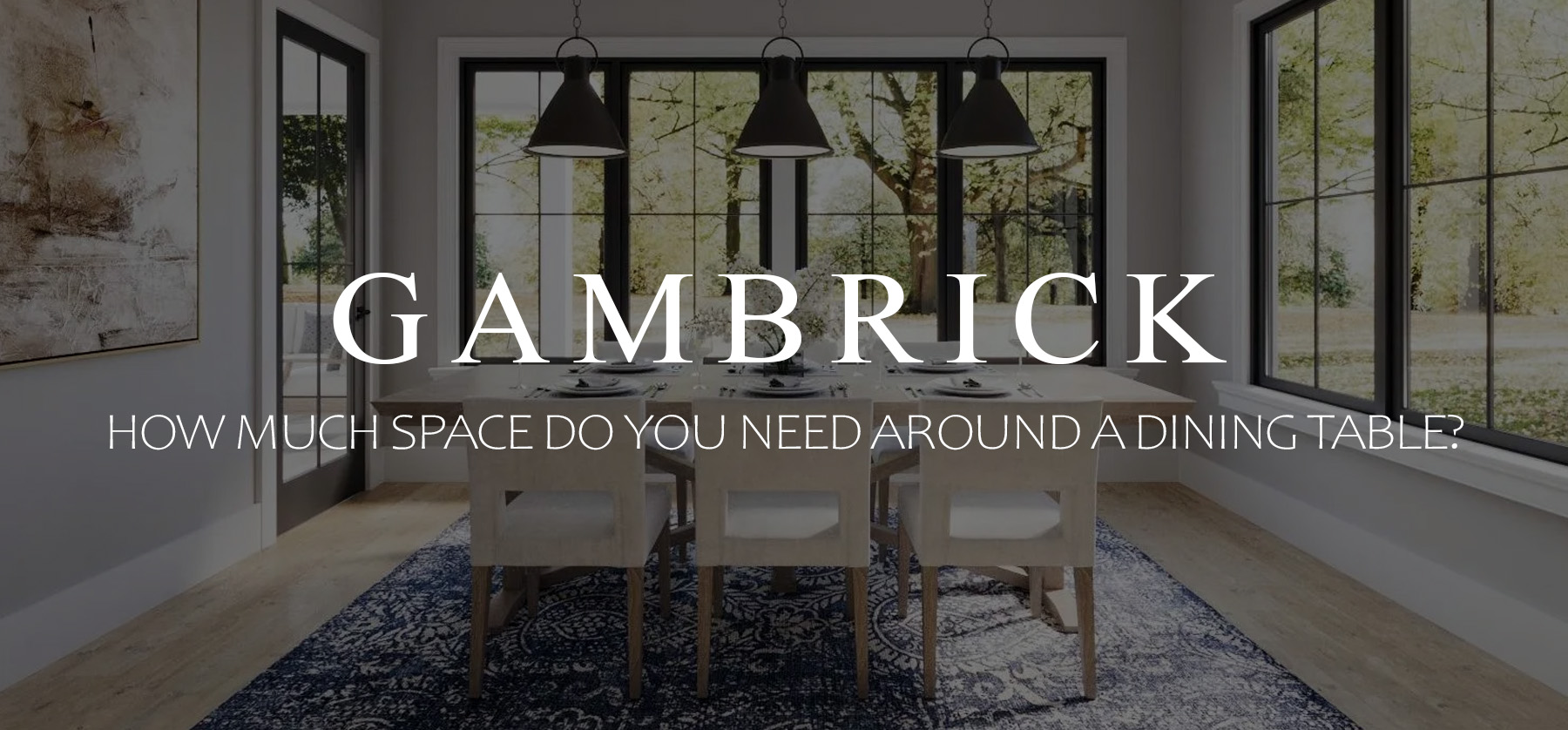How Much Space Do You Need Around A Dining Table?
You should leave at least 36 inches of space around a dining table on all sides that have chairs. Measure the space between the edge of your table and other furniture or walls. 3 Feet provides enough room for someone to walk behind the chairs while others are seated or to comfortably push the chair out to sit down. It’s also plenty of room to open cabinets or drawers that are nearby. Any less space than 36 inches and you’ll be bumping into things or uncomfortable. You don’t want the dining table to feel cramped while getting up or sitting down. This measurement is just a guide and should be increased based on the size of the people living in the home.
A dining room rug should extend at least 24 inches from the edge of the table to the edge of the rug on all sides with chairs. All the chairs should have a rug under them even when they’re pushed away from the table. 2 Feet gives you plenty of room and prevents chair legs from catching on the edge of the rug.
Dining tables should be at least 30 to 36 inches wide. 3 Feet or larger provides enough room for platters, bowls, pitchers and centerpieces as well as dishes, place settings, glasses and silverware.
Overhead chandeliers or pendant lights should be hung at least 30 inches above the table to keep sight lines open. Keep them in the center of the table or at least 6 inches from the edge. This is enough room to prevent someones head from bonking the light.
When setting the table, allow 18 to 24 inches for every person at your table. But that measurement can adjust up or down depending on your guests.
How To Layout A Dining Table
You need 3 feet of space from the edge of the table to the wall or other furniture. It doesn’t matter if the table is round, square, oval or rectangular, the same amount of space is needed. While you may be tempted to purchase a dining table because it looks good and seats lots of people, you should always make sure it fits in the room before buying. Measuring and laying out the dining table’s location before hand helps prevent buying a table that’s too large for the room.
The dining table’s distance from any wall should be at least 36 inches to comfortably fit the room. This minimum amount of space allows for a few things:
- Chairs to be comfortably pulled out to it or stand
- Drawers or cabinets behind the seats can be opened while people are sitting
- Enough space to walk behind the chairs while people are sitting
Laying out a dining room table is very simple. There are two ways to do it:
- Measure out from the table’s edge’s 3 feet in each direction. No furniture or walls should be placed within this space. This work well in large rooms where you’ve got plenty of space for a table and other furniture.
- In smaller room you should measure in from the walls and furniture. This will help you find the correct size table. Small rooms have less options because you can’t fit as big a table. By measuring in from the walls instead of out from the table, it prevents buying a table that’s too big for the room.
How To Calculate The Right Size Dining Table
Figuring out how much space is needed for a dining table and chairs is relatively easy if your room is rectangular or square. Measure the length and width of the dining room and subtract 6 feet from each measurement. This number gives you the maximum size square or rectangular dining table that will fit.
For example, if the room is 12 feet x 14 feet, the largest dining table that’ll fit comfortably in the room is 6 feet x 8 feet. By subtracting 6 feet from the total measurement you place the table 3 feet from each wall.
Keep in mind that you also need to account for other furniture if the room if it has any. In that case, measure from the edge of the furniture and not the wall.
An exception to this rule is corner furniture. If you’ve got a cabinet the corner that won’t be in anyone’s way when they’re seated or walking around the dining table, there’s no need to measure how much floor space the cabinet takes. The reason why we measure 3 feet from all sides if because that’s where the chairs are. If chairs don’;t back up into the corners then they’re typically not an issue.
However, a cabinet centered along the wall should be considered if it’s directly behind any chairs. In this case, keep the required 36 inches between the cabinet and dining table.
Round and oval dining tables aren’t treated any different from square or rectangular unless the chairs come out at an angle. Some people position the chairs on a rounded dining table so that they pull out into the corners of the room. In this case, keep 36 inches between the chairs and corner furniture.
Finding The Right Size Dining Table Summary:
- Measure the length and width of your dining area. Don’t forget about other furniture in the room. If you have a cabinet along a wall, measure from the edge of the cabinet to the edge of the table, not from the table to the wall.
- Subtract 6 feet from both the length + width of the space to allow a 3’ of clearance.
- The result is the maximum recommended size for your dining table. For example, if you have a 12’ x 14’ space, the maximum size dining table you should buy is 72” x 96”.
Dining Table Buying Tips
Here’s a few tips that may help you buy your next dining room table. I’ve designed dozens of dining rooms over the years and these tips always come in handy.
- Versatility: An expandable table with leaves allows you to seat more people when you need too. But you can break the table down when company is gone. This is a nice feature because a huge one piece dining table isn’t always the best choice for every home but sometimes you need the extra space. A versatile table is great for a small family or someone living alone that occasionally has parties.
- Round Dining Tables: For a square room, small space or multi-use room, a round pedestal table can be a great choice. They take up less space and are easy to walk around. And you can buy them with an optional center leaf or two that can turn a small round table into a larger 6 or 8 seated table.
- Tight spaces: Create a dining nook in a corner using banquette seating.
- 2’ rule: For a rectangle table, allow at least 2′ per person for casual dining and 30 inches for something more formal. Keep place setting spacing in mind when buying a table.
How Many Seats Does A Dining Table Have?
Here’s a breakdown of average sized dining tables and how many seats they have. Keep in mind these tables are all 30-36 inches wide which is the standard dining table width.
Each leaf generally expands a dining table to seat 2 more chairs. Expandable dining table usually allow 1-2 leafs.
- 48”-long table seats 4
- 60-72” table seats 6
- 80-87” table seats 8
- 92-108” table seats 10
- 120” table seats 12
- 42-48”-diameter round table seats 4
- 60” round table seats 6-8
How Do Chairs Effect Dining Table Size
The size of your chairs effects the size the dining table should be. Here are some general guideline you should know.
- Most side chairs range between 16” wide and 24” wide.Side chairs don’t have arm rests. Typically they go on the sides of the table which is why they’re called side chairs.
- Arm chairs average 24″ to 30”. Many dining tables have all arm chairs while other only use them at the heads of the table.
If your chairs are 24” wide or wider, add an additional 6” to the total width of your table setting.The wider the chair the more space you need between people. This then effects the size of the table you’ll need.
You can buy a table and chairs in a few different ways.
- Buy the table first and then the select chairs to match the table size you got.
- Pick the chairs first and then choose an appropriately sized table.
- Buy a dining table and chair set.
When you buy the right size chairs to go with your dining table size, you ensure everyone has enough room. Remember, 24 inches between place setting is a guide not a steadfast rule. If you use wide chairs up that to at least 30 inches between settings.
Always measure the chairs at their widest point. For some chairs this is at the arm rests but for others it’s the seat.
If you’re trying to maximize seating then consider adding a bench to one or both sides. This is the easiest way to adjust your place settings because you don’t have to worry about chairs hitting one another. And kids love them.
What’s The Right Apron Length For A Dining Table?
Most chairs have a seat height between 17” and 20”and most dining tables are around 28″ to 30” tall. Allow between 10” to 12” of space between the top of the chair seat and your table bottom.
When selecting an apron, allow approx. 7” of space between the seat of your chair and the apron. This is generally enough room so that legs don’t hit the apron when sitting.
Counter height tables sit at 36” high. This is the same height as a kitchen bar or island countertop. These tables are a great option for informal spaces but are sometimes used in the dining room.
A 42” bar height table is rarely used in the dining room. But if you do, the same size between the table and chair seat should apply. Most high tables also have higher seats so the relation of the seat to table top remains the same as a standard dining table.
Dining Table Space Per Person
How to space your table settings is another thing to consider. It’s important for each guest to sit comfortably without bumping elbows. Of course this can be adjusted based on who’s over for dinner. At my house we pack as many chairs as we can fit around the dining table but it’s a family dinner not something formal. In general, at least 20 to 24 inches of space is needed per person, or chair.
For more formal dinners, more space between guests is usually given. In this case, at least 30 inches of space is needed between settings.
If you want a table that works for both everyday use and more formal occasions, choose a table with an extra leaf or two that can be installed when needed. Also buy a few extra matching chairs just in case.
How Much Room Do You Need For A Six Person Dining Table?
A 6 person dining table should be at least 78″ long. That’s 6 feet 6 inches. The rule of thumb is to allow 24″ of space per seat at your dining table for casual seating. For more formal meals, you should allow 30″ per seat which still works with a 78″ table.
How Much Room Is Needed Between A Dining Table And A Wall?
The distance between a wall and the dining room table should be 36 inches or 3 feet. This measurement is taken from the edge of the table to any walls or other furniture that sit behind chairs. 3 Feet on all sides allows seats to slide out easily, drawers and cabinet doors to open and space to walk behind chairs when people are seated.
What Size Dining Table For A 10×10 Room?
For a 10′ x 10′ room you can fit a 4′ x 4′ square or round table with 4 chairs. If you have other furniture inside the room, you can use a 48″ x 30″ rectangular table with 4 chairs. This will give you some room for a storage cabinet against one wall.
Remember the ideal space between the edge of a dining table and the wall or other furniture is 36 inches. But that’s just a guide. You can comfortably cut that down to 32″ or even 30″ if you have slim chairs. I’ve designed some small dining room and had great success using slim chairs.
The reason why you want 36″ behind the chairs is so they can comfortably pull out to sit or get up and for space to walk around when people are seated. With really slim dining chairs, you have enough room to do those things. It’s tight, but I’ve been able to make it work. I usually prefer a slightly bigger table over maximum spacing.
The Breakdown
Here’s a simple breakdown for determining the right size dining table for your room:
- Allow at least 3’ of clearance on each side of the table. That’s the minimum amount of space you need to pull out chairs from the table, open up cabinets or drawers, or to walk behind people seated at the table. Measure from the edge of the table to the wall or furniture behind it.
- Take other furniture into account. If you have other furniture in the dining room, measure 3’ from the edge of the table to the furniture.
Dining Table Gallery
Here’s a small gallery filled with some of my favorite dining tables. Each of them sticks to the recommended 36″ between the table’s edge and walls or furniture.
Square wood dining table with 4 wicker chairs.
Rectangle wood and white country style dining table with 4 plush chairs.
Round dark wood dining table with 4 gray chairs.
Oval wood dining table with 8 brown leather chairs.
Country style rectangle wood dining table with 8 chairs.
Modern oval marble dining table with 6 cream chairs.
Modern dark wood rectangle dining table with 10 plush golden chairs.
Dark wood square dining table with 8 plush cream chairs.
Beautiful dining room with light wood rectangular table and 6 cream chairs.
Summary: How Much Space Do You Need Around A Dining Table?
You should leave at least 36 inches of space around a dining table on all sides that have chairs. Measure the space between the edge of your table and other furniture or walls. 3 Feet provides enough room for someone to walk behind the chairs while others are seated or to comfortably push the chair out to sit down. It’s also plenty of room to open cabinets or drawers that are nearby. Any less space than 36 inches and you’ll be bumping into things or uncomfortable. You don’t want the dining table to feel cramped while getting up or sitting down. This measurement is just a guide and should be increased based on the size of the people living in the home.
A dining room rug should extend at least 24 inches from the edge of the table to the edge of the rug on all sides with chairs. All the chairs should have a rug under them even when they’re pushed away from the table. 2 Feet gives you plenty of room and prevents chair legs from catching on the edge of the rug.
Dining tables should be at least 30 to 36 inches wide. 3 Feet or larger provides enough room for platters, bowls, pitchers and centerpieces as well as dishes, place settings, glasses and silverware.
Overhead chandeliers or pendant lights should be hung a minimum of 30 inches above the table to keep sight lines open. Keep them in the center of the table or at least 6 inches from the edge. This is enough room to prevent someones head from bonking the light.
When setting the table, allow 18 to 24 inches for every person at your table.
If you have any questions or comments about dining tables, email any time.
































